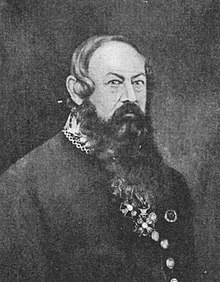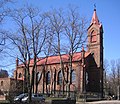Ernst Bernhard Lohrmann
Ernst Bernhard Lohrmann (born June 30, 1803 in Übelngönne ; † June 17, 1870 in Stockholm , Sweden ) is a Finnish architect born in Germany . His father held the position of senior rentier. He was married to Caroline Julie Stagge around 1838.
Vita
Ernst Berhard Lohrmann began his studies in Göttingen in 1821 with the subjects philosophy and camera art at the University of Göttingen and from 1823 at the University of Berlin. He soon concentrated on studying at the Berlin Building Academy. In 1827 he graduated as a surveyor in Berlin.
After completing his studies, he worked as a building inspector until he left for Finland in 1841. In the process, he left some traces on his work in Berlin: He planned and implemented a comprehensive new construction program for the management of the Berlin clinic facilities. His other works in Berlin include the preserved main building of the veterinary school (1840) in Luisenstrasse, a representative example of the so-called classical architecture school Schinkelska and a suspension bridge in the zoo.
Now staying in Finland, he succeeded Carl Ludwig Engel as director of the administrative office of the Finnish building authority and in 1867 became general director of the overall organization. During its time, Finland experienced a radical change in architectural style from classicism to historicism . Lohrmann's activity was productive, but views on his architectural directions are divided.
As an architect, Ernst Lohrmann was a proven specialist in the design of churches and public buildings.
Selected church buildings
- 1846: Kuhmalahti Church
- 1846: Church of Simo
- 1848: Kerimäki Church
- 1849: Suomusjärvi Church
- 1850: Ylöjärven Church
- 1851: Church of d'Ylistaro
- 1851: Lapväärtti Church
- 1851: Rääkkylä Church
- 1852: Church of Muolaa
- 1852: Helsinki Cathedral
- 1852: Ruokolahti Church
- 1852: Old Church of d'Humppila
- 1853: Church of d'Utsjoki
- 1855: Kestilä Church
- 1857: New Hattula Church
- 1858: Enontekiö old church
- 1860: Henrik Cathedral
- 1863: Juva Church
- 1866: Mäntsälä Church
- 1869: Tuusniemi Church
- 1870: Hämeenkoski Church
- 1874: Kuivaniemi Church
- 1878: Church of Isokyrö
Other public buildings
- 1849–1851: House of good humor
- 1853: Turku prison
- 1864: Finnish Finance Bank
- 1865: Kristinestad Town Hall
- Hakasalmi's villa
- Aleksanteri Institute
gallery
Villa d'Hakasalmi on Mannerheimintie Street in Helsinki .
House of good humor , Oulu .
Web links
Individual evidence
- ↑ Biography Lexicon for Finland
- ↑ Biographical information, cf. Ernst Bernhard Lohrmann
- ↑ Pasi Kovalainen, Hyvän Mielen talo. Oulun kruununmakasiinin 152 ensimmäistä vuotta., Riihisäätiö ja Hyvän mielen talo ry., 2003 ( ISBN 951-98706-1-X )
| personal data | |
|---|---|
| SURNAME | Lohrmann, Ernst Bernhard |
| BRIEF DESCRIPTION | German architect in Finland |
| DATE OF BIRTH | June 30, 1803 |
| PLACE OF BIRTH | Indulge yourself |
| DATE OF DEATH | June 17, 1870 |
| Place of death | Stockholm , Sweden |








